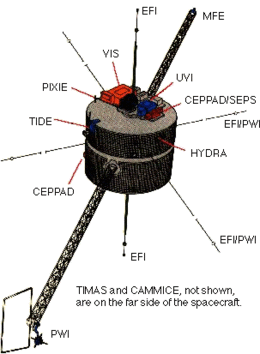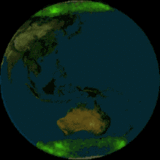Polar (satellite)
 Polar diagram | |
| Mission type | Earth observation |
|---|---|
| Operator | NASA |
| COSPAR ID | 1996-013A |
| SATCAT № | 23802 |
| Website | Polar home page |
| Mission duration | 12 years |
| Spacecraft properties | |
| Manufacturer | Lockheed Martin Space Systems |
| Launch mass | 1,300 kg (2,900 lb) |
| Power | 333 watts |
| Start of mission | |
| Launch date | February 24, 1996, 11:24:00 UTC |
| Rocket | Delta II 7925-10 |
| Launch site | Vandenberg SLC-2W |
| Orbital parameters | |
| Reference system | Geocentric |
| Regime | Highly elliptical |
| Semi-major axis | 35,490.71 km (22,052.90 mi)[1] |
| Eccentricity | 0.7324219[1] |
| Perigee | 3,125 km (1,942 mi)[1] |
| Apogee | 55,113 km (34,246 mi)[1] |
| Inclination | 78.94 degrees[1] |
| Period | 1109.04 minutes[1] |
| RAAN | 292.36 degrees[1] |
| Argument of perigee | 0.55 degrees[1] |
| Mean anomaly | 1.210 degrees[1] |
| Mean motion | 1.210[1] |
| Epoch | 20 January 2015, 23:01:26 UTC[1] |
| Revolution number | 9753[2] |
The Global Geospace Science (GGS) Polar Satellite was a NASA science spacecraft designed to study the polar magnetosphere and aurora. It was launched into orbit in February 1996, and continued operations until the program was terminated in April 2008. The spacecraft remains in orbit, though it is now inactive. Polar is the sister ship to GGS Wind.
Launch
It was designed and manufactured by Lockheed Martin, and launched at 11:23:59.997 UTC on February 24, 1996 aboard a McDonnell Douglas Delta II 7925-10 rocket from launch pad 2W at Vandenberg Air Force Base in Lompoc, California, to study the polar magnetosphere.
The spacecraft was placed into a highly elliptical orbit with apogee at 9 Earth radii and perigee at 1.8 Earth radii (geocentric), 86 degrees inclination, with a period of around 18 hours. The apogee was initially over the northern polar region, but has since been precessing south at about 16° per year.
Operations
Sensors on the spacecraft gathered multi-wavelength imaging of the aurora, and measured the entry of plasma into the polar magnetosphere and the geomagnetic tail, the flow of plasma to and from the ionosphere, and the deposition of particle energy in the ionosphere and upper atmosphere.
The nominal mission duration was two years, but was extended several times. Polar Mission Operations were finally terminated on April 28, 2008.[3][4]
Characteristics
Polar is a cylindrical satellite of 2.4 meters in diameter and 1.8 meters in height built by the "Astro Space" division of Martin Marietta. WIND is a stabilized satellite rotation at a speed of 10 rpm about its axis which is maintained perpendicular to the plane of the ecliptic. A platform that serves as support for certain instruments (including imaging) require that their field of view is fixed is fixed to the top of the satellite and rotates in the opposite direction. Satellite walls are covered with solar cells that provide 440 watts of electricity including 186 W are used by the scientific instruments. The satellite has a mass of 1297 kg, including 269 kg of propellant and 264 kg payload. It is designed for a minimum lifetime of 2 years. Scientific data are stored on a digital recorder with a capacity of 1.3 gigabits and transmitted at a rate between 56 and 512 kb. Polar is the twin satellite WIND.
Scientific Instruments

Polar carrying 11 scientific instruments representing a mass of 264 kg:
Five instruments studying the local electromagnetic fields at low frequency:
- MFE (Magnetic Field Experiment)
- EFI (Electric Fields Instrument)
- PWI (Plasma Wave Instrument)
- HYDRA (Hot Plasma Analyzer Experiment)
- TIDE/PSI (Thermal Ion Dynamics Experiment / Plasma Source Investigation)
Three instruments responsible for studying populations of particles associated with electromagnetic fields:
- TIMAS (Toroidal Imaging Mass Angle Spectrograph)
- CAMMICE (Charge and Mass Magnetospheric Ion Composition Experiment)
- CEPPAD (Comprehensive Energetic Particle-Pitch Angle Distribution)
Three imagers responsible for providing a comprehensive view of the processes that interact with the upper atmosphere:
- UVI (Ultraviolet Imager)
- VIS (Visible Imaging System)
- PIXIE (Polar Ionospheric X-ray Imaging Experiment)
Results
Polar collected images of auroras in multiple wavelengths. She also measured the amount of plasma used in the polar regions of the magnetosphere, the flow of the latter in the ionosphere and the entry of other charged particles in it and in the upper atmosphere. For the first time the entire sequence of events initiated by magnetic substorms to the generation of the aurora was observed in detail. The collected data and determined that solar storms deposited such an amount of energy in the ionosphere that it stretched to fill the magnetosphere completely. Polar instruments were used during the primary mission of the THEMIS satellite between January and April for his study of magnetic tail.[5]
Other names

- POLAR
- GGS/Polar
- ISTP/Polar
- Polar/GGS
- Polar/ISTP
- Polar Plasma Laboratory (PPL)
- NORAD Satellite Catalog Number: 23802
- NSSDC International Designator: 1996-013A
References
- 1 2 3 4 5 6 7 8 9 10 11 "POLAR Satellite details 1996-013A NORAD 23802". N2YO. 20 January 2015. Retrieved 25 January 2015.
- ↑ Chris Peat. POLAR - Orbit. Heavens-Above. Retrieved 2016-06-27.
- ↑ Lockheed Martin Press Release, April 30, 2008
- ↑ 'Broken Heart' Image the Last for NASA's Long-Lived Polar Mission
- ↑ POLAR. EO Portal. Retrieved 2016-06-27.